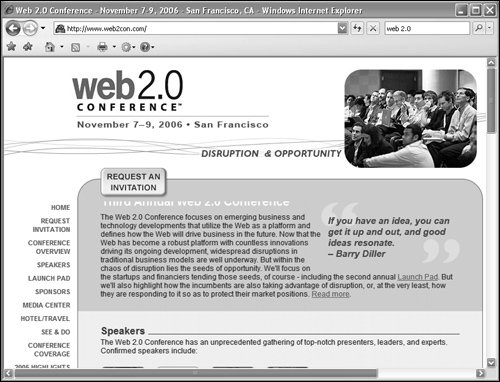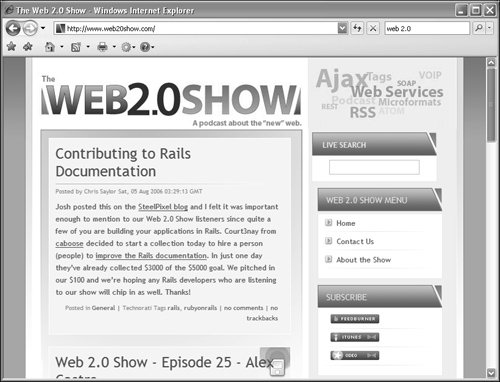| If you have been paying attention to anything Web-related in the last few years, then you have probably come across the term Web 2.0. Although some might dismiss it as another techno-babble buzzword, it is becoming increasingly pervasive with many companies building their strategies around the concept. At it's simplest, Web 2.0 embodies the belief that the World Wide Web is breaking away from its origins and evolving into the next stage of human interaction with a computer and the global community. The buzzword took on a life of its own, when in 2004 Tim O'Reilly hosted the first Web 2.0 Conference (Figure 19.9), where he and other Web and business pundits laid down the core Web 2.0 principals: Figure 19.9. The Web 2.0 Conference (patent pending) is the center of the buzz. 
The Web as application delivery platform. Rather than purchasing software to be run from your desktop, applications can be licensed and run over the Web. The end of software versioning. Rather than having discreet software versions, applications are constantly being updated and improved. Data as a driving force. Information becomes the center of development. Visitor contributions through an "Architecture of Participation." Everyone is able to create and distribute content in an open community. Ubiquitous content and service syndication. Rather than isolated islands of information, the Web becomes a personalized distribution network. A "long tail" approach to content delivery. Rather than a few creating content for the masses, the masses create content for the few. For more details, see the sidebar "The "Long Tail" of Content."
Regardless of how the term came about, Web 2.0 appears to be sticking as a way to describe next generation Web applications. For it's part, Ajax also seems to be forming the technological cornerstone of Web 2.0, since it allows for a smoother online application user interface and data transfer. In fact, Ajax is becoming such an integral part of the fabric of the Web that it has it's own recognizable design style (see the sidebar "What Does Web 2.0 Look Like?"). The "Long Tail" of Content Chris Anderson coined the phrase the long tail to describe a trend he was noticing on the Web in which goods and services that normally might be considered part of a niche market, such as a cult movie, songs by a fringe band, or an obscure weblog, end up being very popular in aggregate compared to other obviously popular goods and services. For example, any one of thousands of cult movies available from Netflix might have extremely low rental rates compared to a typical "blockbuster" movie. But because the Web doesn't have limited shelf space available to house rentals like the local video rental store does, online rental companies like Netflix can afford to make "unpopular movies" available. If you add up the rental of all of these unpopular movies, you might be surprised to find that they can actually account for more sales than the blockbusters. While this explanation is somewhat simplifiedthere's more to it than just the niche marketthe big idea is that Web 2.0 can accommodate niche markets and specialized content and make it easily available to a wider audience. For more details (and to find out where the term "long tail" comes from), there is no better place to start than with Anderson's original article (wired.com/wired/archive/12.10/tail.html). |
Why Web 2.0 Now? A variety of different influences have made this a ripe time to think about new ways of dealing with the Web. Browser standards are becoming increasingly solid and predictable, allowing Web designers to create innovative Web pages they know will work for the majority of their users, with few caveats. High-speed Internet access is becoming increasingly ubiquitous, meaning that visitors have to wait less for more robust content. Better delivery systems for robust graphic, audio, and video content have evolved and matured in the last few years. As a social platform, the Web is becoming increasingly indispensable, especially among younger audiences. Familiarity and reliance on the Web is consistently growing, allowing content providers to rely on a steadily growing and increasingly Web-savvy audience. Web 2.0 is an attempt to capture this rising "upgrade" to the Web. However, it also emphasizes the increasingly participatory nature of the Web through the use of tags, blogs, comments, wikis, ranking, and the general free sharing of content using APIs, Ajax, and other open-source technologies that free Web sites from their "walled garden" mentality.
What Does Web 2.0 Look Like? The term may be only a few years old, but it has already spawned a noticeable design trend amongst Web sites that claim to be a part of the Web 2.0 revolution (Figure 19.10). These sites tend to include: A lot of gradient or diagonal hatch-mark (or both) backgrounds Large colorful icons, with 3D effects such as reflections (called the Wet Floor effect) and drop shadows Large, bold header text Glossy 3D elements like what you see in Apple's OS X interface Lots of highlights and text call-outs that appear for no obvious reasons
For a wry look at the Web 2.0 design phenomena (and what it looks like), check out Hypocritical's "Web 2.0 interface design checklist" (hypocritical.com/blog/2005/12/web-20-interface-design-checklist.asp). Figure 19.10. The home page for "The Web 2.0 Show" podcast is a good example of the Web 2.0 "look." 
|
Ajax and Rich Internet Applications Although there are a lot of technologies that allow the delivery of applications that feel like stand-alone software over the Web (such as Flash, Java, and ActiveX), Ajax is proving to be a driving force in many Web 2.0 Rich Internet Applications (RIA). RIAs make use of Ajax to create robust user interfaces within the browser window to do everything that you might be able to do with a stand-alone application downloaded directly to your computer. We still have a long way to go before we see RIAs that truly rival their desktop counterparts, but this is a growing area of Web development. For a list of some of the more interesting RIAs already deployed, see Table 19.1. Table 19.1. Rich Internet Applications |
|---|
NAME | URL | DESCRIPTION | Google Maps | maps.google.com | World maps | 24SevenOffice | 24sevenoffice.com | Resource planning and customer relationship software | Flickr | flickr.com | Photo storage and cataloging software | FORScene | forbidden.co.uk/products/scene/ | Video logging, editing, and reviewing tools |
|

